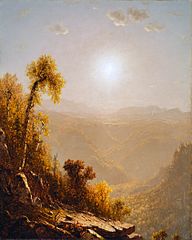
Catskill Mountains
The Catskill Mountains, also known as the Catskills, are a physiographic province and subrange of the larger Appalachian Mountains, located in southeastern New York. As a cultural and geographic region, the Catskills are generally defined as those areas close to or within the borders of the Catskill Park, a 700,000-acre (2,800 km2) forest preserve protected from many forms of development under New York state law.
Catskill Mountains
4,180 ft (1,270 m)
111 mi (179 km) N/S
102 mi (164 km) E/W
15,259 km2 (5,892 sq mi)
United States
Geologically, the Catskills are a mature dissected plateau, a flat region subsequently uplifted and eroded into sharp relief by watercourses. The Catskills form the northeastern end of the Allegheny Plateau (also known as the Appalachian Plateau).[1][2]
The Catskills were named by early Dutch settlers. They are well known in American society as the setting for films and works of art, including many 19th-century Hudson River School paintings, as well as for being a favored destination for vacationers from New York City in the mid-20th century. The region's many large resorts gave many young stand-up comedians an opportunity to hone their craft. Since the late 19th century, the Catskills have been a haven for artists, musicians and writers, especially in and around the towns of Woodstock and Phoenicia.
Recreation[edit]
The Borscht Belt[edit]
In the mid–20th century, summer resorts in the Catskills, nicknamed the Borscht Belt, were a major vacation destination for Jewish New Yorkers. At its peak of popularity, about 500 resorts operated in the region.[10] Later changes in vacationing patterns have led most of those travelers elsewhere, although there are still some bungalow communities and summer camps in the region catering to Orthodox populations.
From 1872, the northern part of the Catskills were served by the Catskill Mountain Branch of the Ulster and Delaware Railroad which was absorbed into the New York Central railroad in 1932. Oneonta to Kingston passenger rail service continued until 1954. Part of the line still exists but now serves only freight.
The southern part of the Catskills was served by the New York, Ontario and Western Railway. Over the course of 1950, service on the NYO&W downscaled to summer only. In its last years it ran trains from Roscoe to Weehawken, New Jersey, via Liberty. It connected with the New York Central's West Shore Railroad at Cornwall.[17][18] This service lasted until September 10, 1953.[19]
The Delaware and Ulster Railroad is a heritage railroad, based in Arkville, New York, that still runs a scenic part of the track from Highmount to Hubbell Corners, New York, for tourist use. The Catskill Mountain Railroad is also a heritage railroad in the Catskills, operating from Kingston up to Highmount.
The Catskills are accessible by automobile from the east along Interstate 87/New York State Thruway, which runs north–south through the Hudson Valley. To the south and southwest, the Catskills are accessible by a variety of highways, including New York State Route 55, U.S. Route 44, U.S. Route 209, and New York State Route 17. Access to the western Catskills is provided by New York State Route 30; and the vaguely defined far-western edge of the region is variously considered to be New York State Route 10 or Interstate 88, though this boundary remains a matter of local preference. New York State Routes 28 and 23A cut east–west through the heart of the Catskills, serving many of the most popular outdoor tourist destinations. New York State Route 23 runs east–west across the Catskills' northern section.
The closest major airports to the Catskill region are Albany International Airport to the north and Stewart International Airport in Newburgh to the south. Smaller airports in the region include:
The Catskills serve as the setting for many works of fiction, such as the short story Rip Van Winkle, and the children's book My Side of the Mountain. The Hudson Valley Film Commission maintains a list of films set in the Hudson Valley/Catskills Region.[20] Of them, more than three dozen films are set in the Catskills.
The town of Bethel, New York, located in the Catskills, was home to the famous Woodstock music festival that took place August 15–18, 1969. The event, wherein 32 music acts performed in front of over 500,000 concert-goers, was captured in the documentary movie Woodstock (1970). The site is now home to the world-renowned Bethel Woods Center for the Arts.
The many hotels and vacation resorts located in the Catskills are notable in American cultural history for their role in the development of modern stand-up comedy. Comedians such as Rodney Dangerfield, Jackie Mason, Alan King, and Don Rickles all got their start performing in Catskill hotel venues colloquially referred to as the Borscht Belt.[21]



![The Catskills, 1859 painting by Asher Brown Durand depicting the Catskills using the "sublime landscape" approach[22]](http://upload.wikimedia.org/wikipedia/commons/thumb/2/2b/Asher_Brown_Durand_-_The_Catskills_-_Walters_37122.jpg/193px-Asher_Brown_Durand_-_The_Catskills_-_Walters_37122.jpg)

